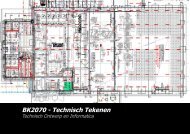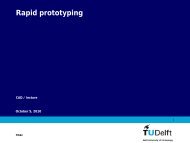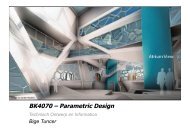Perception Aspects in Underground Spaces using ... - TOI - TU Delft
Perception Aspects in Underground Spaces using ... - TOI - TU Delft
Perception Aspects in Underground Spaces using ... - TOI - TU Delft
Create successful ePaper yourself
Turn your PDF publications into a flip-book with our unique Google optimized e-Paper software.
CHAPTER 1Introduction1.1. Background and research problemThroughout the centuries, the Netherlands has been confronted with various <strong>in</strong>terests that havecompeted for space, plac<strong>in</strong>g more and more pressure on scarce land. The economic growth,which characterized the last decade, caused an additional pressure not only on land due to newfunctional requirements but also on spatial quality. The new development strategies are verymuch aligned with these issues. In the Fifth Bill regard<strong>in</strong>g Spatial Plann<strong>in</strong>g of the Netherlands(VROM, 2001), the ma<strong>in</strong> strategies for future developments are <strong>in</strong>tensification, comb<strong>in</strong>ation andtransformation with a goal to utilize exist<strong>in</strong>g urban space more efficiently and effectively and atthe same time provide better spatial quality. In that context, the concept of multiple space usageis accentuated, which would focus on an <strong>in</strong>tensive 4-dimensional spatial exploration. In thedocument 'Spatial Exploration 2000' (Ruimtelijke Verkenn<strong>in</strong>g 2000) the underground space isrecognized by policy makers as an important new 'frontier' that could provide significantcontribution to future spatial requirements as an essential part of multiple space usage (VROM,2000).In a relatively short period, underground space became an important research area. This space hasthe potential to improve urban environment by reliev<strong>in</strong>g pressure from the surface, improv<strong>in</strong>gmobility by expand<strong>in</strong>g public transport network, reduc<strong>in</strong>g noise and improv<strong>in</strong>g air quality,leav<strong>in</strong>g more green areas <strong>in</strong> the city center <strong>in</strong>tact, and reduc<strong>in</strong>g distances by better concentrationof functions and efficient use of space. This altogether should help improve quality of life <strong>in</strong>urban areas, but at the same time, these spaces should guarantee their own quality as well. In1994, Dutch government <strong>in</strong>itiated the establishment of the COB (Center for Build<strong>in</strong>g<strong>Underground</strong> - Centrum Ondergronds Bouwen) which would coord<strong>in</strong>ate the research andknowledge accumulation related to underground space. Although among specialists there is anappreciation of what underground space could provide for densely populated urban areas, thereare still reserved feel<strong>in</strong>gs from the public, which are related to the poor quality of these spaces.Accord<strong>in</strong>g to Horvat (Horvat, et. al., 1997), among various technical and juridical issues, one ofthe important potential h<strong>in</strong>der<strong>in</strong>g factors for underground space utilization are psychological- 1 -





